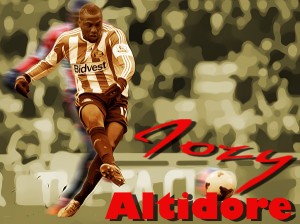
Here’s a serious guest post. We all felt for Jozy Altidore when he pulled up with a hamstring injury in the USA’s first match, vs our old greedy’s Ghana team. The USA were voted Salut! Sunderland’s second team in the World Cup and Jozy’s ours, at least for now. Here Gemma Tomkinson, from the AposTherapy blog (@AposTherapy at Twitter), talks us through the injury and its implications. Brainboxes among our readers can look away; the rest of us may learn something …
Jozy Altidore suffered a hamstring injury after 22 minutes of the first half of the 2-1 victory over Ghana. He had been running down a ball with Ghana’s John Boye when he grabbed the back of his left leg.
So what is a hamstring injury? The hamstrings are a group of three muscles located at the back of the thigh. These muscles are responsible for bending the knee and straightening the hip during activity and are particularly active during running, jumping and kicking.
During contraction of the hamstrings, tension is placed through the hamstring muscles. When this tension is excessive due to too much repetition or high force, one or more of the hamstring muscles can tear. This is known as a hamstring strain. This sometimes occurs with rapid acceleration whilst running or when a footballer performs a long kick. In Altidore’s case it was during sprinting.
Jozy Altidore told reporters after the game “I was sprinting and I felt something … I was crushed. I knew right away I couldn’t continue. It was the worst feeling.”
It appears that Jozy Altidore’s symptoms were more severe than a minor strain as he was unable to continue play and obviously in severe discomfort.
Hamstring injuries can range from a small partial strain to a complete rupture which may require surgical reconstruction. Hamstring strains are graded from grade 1 to a grade 3 tear and are classified as follows:
* Grade 1: A small number of fibres are torn resulting in some pain, but allowing full function.
* Grade 2: A significant number of fibres are torn with moderate loss of function.
* Grade 3: All muscle fibres are ruptured resulting in major loss of function

As with all injuries, a thorough examination is undertaken by the medical team. Further investigations such as an MRI scan or Ultrasound may be required to confirm diagnosis. In Altidore’s case, he’s awaiting MRI results to determine his chances of playing again this tournament.
In terms of rehabilitation from an injury as Altidore’s it is vitally important that treatment starts immediately following injury with the principles of PRICE (protection, rest, ice, compression and elevation).
The initial acute stage of all hamstring injuries will last 24 to 48 hours. After this a full rehabilitation programme should be followed which looks to reduce pain and inflammation, improve flexibility and muscle control and gradually increase the load through the hamstring to a level where you are able to return to full training and match play. The rehabilitation will be designed by a highly trained physiotherapist to include stretching, strengthening, aerobic fitness and sports specific drills. It will be progressed appropriately related to the stages of healing.
Is Altidore out of the World Cup? Many would assume yes but Manager Jurgen Klinsmann remains optimistic and the medical team are working hard with Altidore to give him the best possible opportunity.
Join the Salut! Sunderland Facebook group – click anywhere along this line
![]()
And follow us on Twitter: @salutsunderland … click along this line

Fancy leaving a comment? Not sure what you have to say fits this post? Go to the made-for-purpose feature – https://safc.blog/2013/07/salut-sunderland-the-way-it-is/ – and say it there.